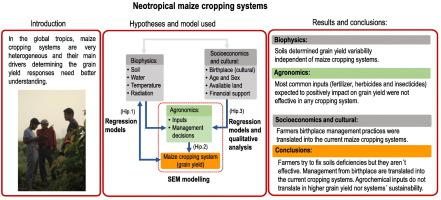Agricultural Systems ( IF 6.1 ) Pub Date : 2022-02-05 , DOI: 10.1016/j.agsy.2022.103370 Germán Wies 1 , Armando Navarrete-Segueda 1 , Eliane Ceccon 2 , John Larsen 1 , Miguel Martinez-Ramos 1

|
CONTEXT
Small-scale cropping systems face enormous challenges in obtaining efficient, stable and predictable responses to grain yields due to their great biophysical, management and socioeconomic complexity. In Mesoamerica, traditional managements have incorporated modern agricultural practices; however, the efficacy of these tools on grain yield and systems´ sustainability is unknown. We explored biophysical, agronomic and socioeconomic drivers determining the maize cropping system and grain yield in Southern Mexico.
OBJECTIVES
The specific objectives were i) to investigate the effects of geopedologic soil characteristics on maize grain yield, ii) characterise tropical maize cropping systems and model how agronomic factors determine grain yield variability and iii) identify underlying socioeconomic drivers, which determine the agronomic ones and, consequently, the maize cropping systems.
METHODS
On-field interviews and soil data from geopedologic unit maps from maize cropping systems in a Mesoamerican region, Chiapas, Mexico, were used. Structural equation modelling (SEM) and quantitative and qualitative analyses were used to explore the data set.
RESULTS AND CONCLUSIONS
We found that cropping systems are differentiated into conventional (CS) and traditional (TS). Soils determined grain yield variability independently from the cropping systems. The most common agronomic inputs expected to positively impact grain yield were not effective in any cropping system. In CS, neither pesticides nor fertilisation determined the crop grain yield; plant density explained 72% of crop grain yield variation. In TS, grain yield was negatively related to plant density, while the fallow period slightly explained grain yield. We identified that cultural practices acquired by the farmers in their birthplace determine the type of the current maize cropping system.
SIGNIFICANCE
We highlight inconsistent modern agronomic management of the studied maize cropping systems where agrochemical inputs (fertilisers and pesticides) do not translate into higher grain yields or systems' sustainability. New theoretical models for small-scale maize cropping systems incorporating socioeconomic and cultural drivers might be necessary to predict better maize grain yield.
中文翻译:

是什么推动了中美洲玉米种植系统的管理决策和粮食产量变化?来自墨西哥南部小农的证据
语境
由于生物物理、管理和社会经济的复杂性,小规模种植系统在获得对粮食产量的有效、稳定和可预测的响应方面面临巨大挑战。在中美洲,传统的管理方式融入了现代农业实践;然而,这些工具对粮食产量和系统可持续性的功效尚不清楚。我们探索了决定墨西哥南部玉米种植系统和粮食产量的生物物理、农艺和社会经济驱动因素。
目标
具体目标是 i) 研究地质土壤特征对玉米产量的影响,ii) 描述热带玉米种植系统的特征,并模拟农艺因素如何确定粮食产量的变异性,以及 iii) 确定潜在的社会经济驱动因素,这些驱动因素决定农艺因素,以及,因此,玉米种植系统。
方法
使用了来自墨西哥恰帕斯州中美洲地区玉米种植系统的地质单元地图的现场访谈和土壤数据。结构方程建模 (SEM) 和定量和定性分析用于探索数据集。
结果和结论
我们发现种植系统分为传统(CS)和传统(TS)。土壤独立于种植系统决定了谷物产量的变化。预计会对粮食产量产生积极影响的最常见农艺投入在任何种植系统中均无效。在CS中,农药和施肥均不决定作物产量;植物密度解释了 72% 的作物谷物产量变化。在TS中,粮食产量与植物密度呈负相关,而休耕期对粮食产量有轻微的解释作用。我们发现农民在其出生地获得的文化习俗决定了当前玉米种植系统的类型。
意义
我们强调所研究的玉米种植系统的现代农艺管理不一致,其中农业化学投入(化肥和杀虫剂)不能转化为更高的谷物产量或系统的可持续性。可能需要结合社会经济和文化驱动因素的小规模玉米种植系统的新理论模型来预测更好的玉米产量。









































 京公网安备 11010802027423号
京公网安备 11010802027423号